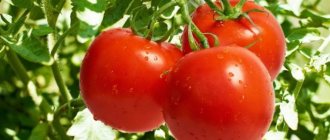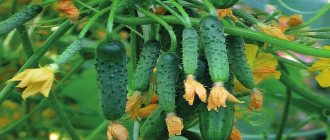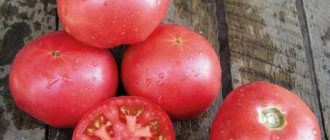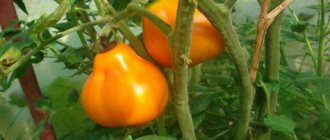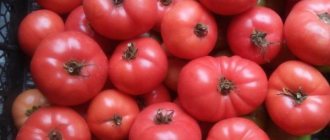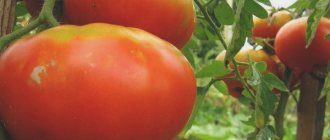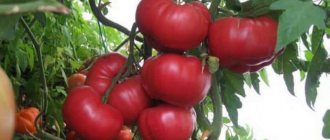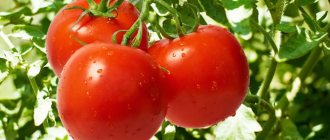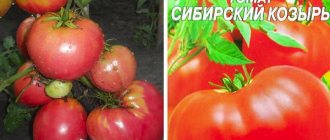Tomato variety "Astrakhan"
Features of the variety
The southern variety of tomatoes belongs to the group of breeding hybrids and has its own characteristics:
- The fruit size is medium;
- Formation of the first inflorescence;
- Small height of the hybrid;
- Average ripening of tomatoes;
- Compactness of the bush;
- Feature of the fruit;
- Wide range of uses.
The formation and localization of the very first inflorescence occurs on the 7th or 8th leaf. Inflorescences are abundantly located on the crown.
The height of the Astrakhan hybrid does not reach a meter. The average is 0.6-0.8 meters. This characterizes this variety as determinate.
The berry hybrid matures approximately 120-124 days after the first shoot. This is characterized as an average.
The bush has a compact appearance, the branches are not spreading, and the leaves are moderately dissected and dark green in color. The corrugation of the sheet is average.
The fruits also have their own characteristics. Their color is red and bright, with a smooth surface without roughness. The size is medium in size. The average weight ranges from 90 grams to 130 grams.
Consumption can occur in various forms. It is delicious in salad, in the form of tomato juice, canned food, or ketchup.
Advantages and disadvantages
- The main advantage of the Astrakhan tomato variety is its high yield. Thanks to the abundant fruiting, an average of 500-600 centners are harvested from one hectare, and experienced farmers under industrial conditions obtain yields of up to 70 tons per hectare. From one bed of an ordinary gardener, the yield is 7-9 kg per 1 sq.m.
- The peduncle is without the usual green spot around it;
- The variety is immune to the tobacco mosaic virus, and is also not affected by the Egyptian broomrape.
- The dense peel can be considered a disadvantage, but this is rather a plus, since the fruit does not crack and is easily transported and stored.
Features of care
Caring for Astrakhan tomatoes is divided into several stages:
- Proper preparation of seedlings and their planting.
- Timely watering. The degree of watering is moderate, and soil moisture is maintained at 80%. One bush uses an average of 4 liters of settled water every day.
- Fertilizer application. The best fertilizer for Astrakhan tomatoes is potassium sulfate and superphosphate.
- Garter.
With proper cultivation of seedlings and decent care, the Astrakhan tomato variety produces a high yield. It is easy to care for and the fruits have a sweet taste.
This is interesting
In production conditions in the Astrakhan region, a special technology was developed, which had the name of the same name as the region. Using this technology, tomatoes were planted with very wide row spacing of 1.4 m and a very small distance between the bushes - 15-17 cm. With this scheme, the row is very dense, the bushes rarely fall apart, there is the possibility of machine harvesting and complete mechanization of all work.
The Astrakhan tomato was approved for use in the Lower Volga and North Caucasus regions for cultivation in open ground and under film covering in 1997.
| Height | Landing location | Ripening time | Fruit color | Fruit size | Origin | Fruit shape |
| Medium height | Greenhouse, Open ground | Mid-early | Reds | Large | Variety | Plum-shaped or oval |
Landing
It is better to sow seeds in the second half of March if you plan to grow them in a greenhouse. For transplanting into open ground, seedlings are sown in April.
After two months, the seedlings can be transplanted.
Proper care will allow you to grow maximum yield
Sowing
Seeds are disinfected with a manganese solution and germinated in a wet cloth. The soil mixture for sowing is prepared from turf soil, peat and a complex of mineral fertilizers.
The seeds are laid out at a distance of 2 cm and deepened into the ground by 0.5-1 cm. The sowing is generously moistened with a spray bottle. The box is closed (with plastic film or glass) and the temperature is set at 24-26°C for 5-6 days.
Seedling
After the shoots appear, the box is opened and moved to the windowsill. The temperature is kept at 16°C for a week. The seedlings are watered every 10 days and the soil is sprinkled with ash powder.
Tatyana Orlova (Vasilidchenko) (candidate of agricultural sciences):
Watering the seedlings is carried out as the soil dries. Ash powder is used at the first symptoms of a disease called “black leg” - rhizoctonia.
After 2 true leaves appear, the plants are planted in separate pots, while fertilizing the soil. Two weeks before transplanting into the garden, the tomatoes begin to harden - they are systematically taken outside or the windows are opened. The time spent in such conditions must be gradually increased so that adaptation gradually occurs.
Transfer
The seedlings are transplanted into a garden bed in loose, fertilized and disinfected soil with manganese. Pre-install a trellis or garden net for tying. The distance between the holes is 50 cm. It is advisable to put compost, ground eggshells, ash, and mineral fertilizers in the planting holes.
When planting, plants should be watered abundantly, using warm, settled water.
We carefully monitor the condition of the branches and tomatoes
Honey giant bushes form 1-2 stems. To do this, remove the side shoots, pinch out the growing point, and cut off several lower leaves once a week. Not only the stems of the plant, but also heavy brushes are subject to garter.
Tatyana Orlova (Vasilidchenko) (candidate of agricultural sciences):
Pinching of the growth point (topping) is carried out either when the tomato plants reach the roof of the greenhouse, or (in cold regions) to speed up the growth and ripening of the fruit.
According to the description, if the grapevine is broken, the tomatoes do not ripen, and if the shoots fall down, the fruits touch the ground and may rot.
Watering
For irrigation, use warm, settled water, and from time to time a solution of manganese or ash.
Water the plants strictly at the root or use the drip method. The procedure is carried out in the morning or evening every 10 days. In hot summers, more often - every week.
Feeding
Fertilizers are applied once every two weeks, alternating organic matter and mineral complexes.
Organic fertilizers are needed for soil fertility, and minerals nourish and strengthen the root system.
If possible, fertilizing is combined with watering using liquid and water-soluble fertilizers. A deficiency of one or another mineral can be quickly compensated for by foliar feeding on the leaves.
Other care measures
To maintain humidity levels, the greenhouse is regularly ventilated. After watering, the soil is loosened and the tomatoes are hilled. As weeds appear, the beds are weeded. Instead of loosening and weeding, you can do mulching. Mulch not only saves the gardener’s effort, but also reduces moisture evaporation.
Pest and disease control
As a preventative measure, Astrakhan tomato bushes should be treated before transplanting into open ground - this can be done using any preparation:
- Bordeaux mixture;
- "Ordan";
- "Fundazol";
- "Maksim";
- "Fitosporin".
Insecticides work well against insects and other pests:
- "Aktara";
- "Fufanon";
- "Aktellik";
- "Karbofos";
- "Green Soap"
In the first stages of the invasion, folk remedies also help to cope - a solution of ammonia, hydrogen peroxide, baking soda, an infusion of chili peppers, onion peels, and a decoction of marigolds.
Important! When growing Astrakhan tomatoes in an open garden bed, treatment is carried out only in clear and windless weather, preferably late in the evening. After spraying the chemicals, tomatoes can be harvested after a few days.
Tomato care
The Astrakhan tomato requires minimal care, which consists of watering and fertilizing. The variety is resistant to tobacco mosaic virus and Egyptian broomrape, and rarely suffers from blossom end rot. It is recommended to tie the bushes to form even stems and prevent the tomatoes from coming into contact with the ground.
Watering the plantings
The Astrakhan variety requires moderate watering. Soil moisture is maintained at 90%. At the same time, the air in the greenhouse must remain dry, which is ensured by ventilating the greenhouse.
Each bush needs 3-5 liters of water. Lack of moisture leads to falling inflorescences, yellowing and curling of the tops. Its excess slows down the development of plants, causes rotting of the root system and provokes fungal diseases.
Advice! Tomatoes require weekly or more frequent watering depending on climate conditions.
For irrigation, use water that is warm and has had time to settle. It is applied strictly at the root to avoid contact with the roots and tops of tomatoes. The procedure is carried out in the morning or evening, when there is no direct rays of the sun.
The first watering is carried out on the 10th day after transferring the tomatoes to the garden bed. During this period, active growth of tomatoes begins, but their root system is not yet developed enough to receive moisture from the deep layers of the soil.
Before flowering, tomatoes are watered twice a week with 2 liters of water. When flowering, tomatoes require 5 liters of water every week. When fruits appear, the frequency of watering is increased to 2 times a week.
Fertilizer application
Fertilizing promotes the development of Astrakhan tomatoes and increases their yield. In total, tomatoes are fed several times during the season. You can use both mineral fertilizers and folk remedies.
The first feeding of tomatoes is done a week after transferring the seedlings to a permanent place. At this stage, it is recommended to apply nitrogen fertilizers in limited quantities, since they contribute to excessive growth of green mass.
Advice! Tomatoes are fertilized with superphosphate and potassium sulfate (35 g per 10 liters of water).
During the flowering period, prepare a 1% solution of boric acid (1 g per 10-liter bucket of water). Plantings are sprayed with it to stimulate fruit formation and prevent the ovaries from falling off.
Feeding with ash will help replace minerals. It is embedded in the ground or an infusion is prepared based on it (a tablespoon per liter of hot water). Wood ash contains a complex of minerals, including calcium, potassium, and magnesium.
Watering a tomato
It is important not to overdo it with watering, since excess moisture greatly impairs the quality of the fruit. In dry, hot weather, the Astrakhan tomato variety needs to be watered 2 times a week. When daytime air temperatures are less than 30 °C, it is permissible to water the tomato once a week. When watering, you need to ensure that there is enough moisture to wet the soil layer at least half a meter.
To do this, you need to give at least 5 liters of water for each bush. If possible, install a drip irrigation system at your dacha. The experience of those who planted and grew these tomatoes in hot climates using drip irrigation suggests that they are very responsive to watering, in which soil moisture is always equally optimal without jumps up or down.
The Astrakhan tomato will definitely delight you with delicious fruits and a large harvest!
To do this, you need to give at least 5 liters of water for each bush. If possible, install a drip irrigation system at your dacha. The experience of those who planted and grew these tomatoes in hot climates using drip irrigation suggests that they are very responsive to watering, in which soil moisture is always equally optimal without jumps up or down.
The Astrakhan tomato will definitely delight you with delicious fruits and a large harvest!
Tie up bushes so they don't lie on the ground
Tomato Astrakhan
General characteristics Mid-season
Ripening period 115 - 122 days after germination
Keeping quality (storage quality) Low
Purpose Salad, canning (for processing into juices and sauces)
Fruit weight up to 200g
Number of fruits per cluster: 4-5
Disease resistance High
Characteristics and description of the variety:
- Bred by domestic breeders and entered into the State Register of the Russian Federation. Designed for planting in open ground and unheated greenhouses. In regions with an unfavorable climate, it is planted in stationary greenhouses.
- Bush of determinant type, standard. The maximum height reaches 80 cm; the bush does not require shaping or pinching. But it is still better to remove excess shoots; this has a positive effect on the yield.
- This is a mid-early variety, from the moment of germination to the harvest of the first harvest, it takes from 115 to 122 days. The fruiting period ranges from two to three months, depending on climatic conditions.
- The yield is up to 4 kg per bush. With a planting density of 3 plants per square meter, up to 12 kg is collected. The indicators are not the greatest, but they are stable and do not greatly depend on external conditions.
- Tomatoes are round in shape. When ripe, they are bright red, without a green spot around the stalk. The average weight is about 100 g, individual fruits grow up to 200 g. and even larger.
- The taste is excellent. The variety is excellent for fresh consumption and is often used in salads and soups. It is also good in preparations: canning whole fruits, making juices, sauces and much more.
- Disease resistance is average. In dry years, plants do not suffer from anything, but in damp years they can be affected by rot and late blight. Pests damage this variety no more than others.
The pulp is juicy and dense, there are no green veins inside
- The variety has a low yield by modern standards.
- Preventative treatment for diseases is required.
In the video, the car places special emphasis on the tomatoes’ resistance to cracking and excellent appearance. https://www.youtube.com/embed/mf8Pq5Yxlys
Features of growing tomatoes Anyuta, planting and care
We recommend sowing the seeds of this tomato for seedlings 55-60 days before the intended planting in the ground. Seedlings dive at the stage of two or three true leaves. When planting seedlings in a permanent place per 1 sq. Place up to 6 plants per meter of plot.
You can see other interesting varieties by looking through our Tomato Catalog with photos, reviews, descriptions. Enjoy watching!
In 2005, the Anyuta hybrid was included in the State Register for the North Caucasus region for garden plots, homesteads and small farms for cultivation in open ground.
Video about the formation of low-growing tomatoes, tying and protection from diseases
If you grew Anyuta tomatoes, please write whether you liked them or not. How is it better than other hybrids? Will you grow it again? How do you rate the disease resistance of this tomato? Briefly describe the advantages and disadvantages of this tomato in your opinion. If possible, attach to the comment a photo of the entire bush as a whole or individual fruits that you grew. Thank you!
Your reviews of the Anyuta tomato and additions to the description will help many gardeners evaluate this hybrid more objectively and decide whether it is worth planting or not.
Website about tomatoes - Tomatland.
Features of growing crops
Seeds are sown in open ground under agrofibre or film in the second ten days of April. At this time, the earth is saturated with moisture and warmed enough by the sun's rays. The seeds are sown in a 7-10 cm hole. The holes are made at a distance of about 40 cm. This is the optimal distance for growing bushes of this tomato variety. No more than three seeds are placed in one hole. Subsequently, they are thinned out, leaving one sprout that looks stronger.
To grow seedlings at home, you buy special soil for seedlings, which contains fertilizers. You can mix this soil with soil from the area where the tomato bushes will grow. This is done for ground leveling. Seeds for seedlings should be sown in early March, and the seedlings themselves should be planted in open ground after 60 days from the date of planting.
Before planting seedlings in open ground, it is advisable to feed the soil with mineral and organic nitrogen-containing fertilizers. Before planting seedlings, about a day before, tomato seeds should be soaked in a weak solution of potassium permanganate, which will act as an antiseptic on them. Seedlings should be watered no more than once every 3-4 days. After 14 days, the first shoots should be clearly visible. The container with seedlings should be stored in a warm place, well lit by sunlight. Somewhere in the second decade of May, the formed bushes are planted in open ground.
Planting sprouted seedlings
This type of tomato does not like either excess moisture or dry weather. You should look at the soil. You can water when the soil has dried out after the previous watering. If the plant receives an excess of moisture, then the fruits will be less fleshy and more watery. Watering is carried out only with warm water, so it is recommended to install drip irrigation over the entire area planted with Astrakhan tomatoes. It is best to water in the evening or early in the morning. This is done so that the leaves and fruits of the bush do not burn, and the root system is not loaded.
It wouldn’t hurt to add 3 tablespoons of ash to a ten-liter bucket once every few weeks and pour this solution over the tomatoes. It protects well from all kinds of pests and diseases. Even though this variety is extremely disease-resistant, new bacteria always appear, which reduces the quality and quantity of the harvest. This variety also requires weeding and fertilizing. It is best to feed with ready-made mineral or organic fertilizers, which contain a mix of useful components. Feeding is carried out 3 times during the tomato growing season
When purchasing fertilizers, you should pay attention to the presence of magnesium, potassium and sodium in them. Fertilizing with urea is also considered popular.
During the period of active growth, tomato bushes need to be fertilized with mullein. 1.5 kg of mullein is diluted in 10 liters of water and left to ferment for a week. Then the resulting fertilizer is diluted with water and the bush is watered at the root. Plants need to be hilled once a week.
Recommendations for cultivation
Description of the variety
The Astrakhan tomato belongs to the group of hybrids with medium ripening periods. It is intended for growing in open ground. It is consumed fresh. The hybrid is processed into juice and tomato paste, and whole fruits are preserved for the winter. Large sown areas are occupied by Astrakhan hybrids in the Lower Volga.
The characteristics and description of the Astrakhan tomato variety are as follows:
- No more than 122 days pass from the first shoots to the ripening of the fruit.
- The height of the plant bush does not exceed 0.8 m. The hybrid forms a standard.
- The first inflorescence is formed above the 7-8 leaves of the bush.
- The shape of the fruit resembles a ball, painted in bright red tones. The tomato skin has medium density. This allows you to transport the crop over long distances, since Astrakhan tomatoes do not crack from mechanical stress. The hybrid has 5-6 seed chambers. Astrakhan tomato seeds are medium in size, but a person does not feel them when eating the fruit.
- Unlike other varieties, the plant does not have a green spot near the stalk.
- The average weight of the fruit ranges from 100 to 105 g. All berries grown on the bush have the same weight. They grow almost simultaneously, so the hybrid is used for growing in industrial conditions.
Reviews from gardeners who managed to plant and grow the described hybrid show that the tomato yield is up to 8 kg of berries per 1 m² of bed. Those farmers who planted and grew tomatoes for sale using a production method indicate that they received a yield of 70-80 t/ha.
A full description of the hybrid can be found in specialized agricultural reference books and catalogs of enterprises involved in the production of plant seeds.
The tomato resists diseases such as blossom end rot and fungal infections well. Doctors recommend eating the fruits for people who have high cholesterol levels, fatty liver disease, decreased general immunity, and problems with the formation of hemoglobin.
Before planting seeds in boxes with homemade or purchased soil, they are disinfected with potassium permanganate. The first shoots will appear 6-7 days after sowing. When 1-2 leaves grow on them, the plants dive.
The grown seedlings are planted on permanent soil according to the 0.5x0.5 m pattern.
There is a production method for planting a hybrid. It is produced according to a 0.17x1.4 m pattern. Then the row is quite dense, and work with tomatoes can be mechanized.
In the second method, the seeds are sown in the ground in April, under a film covering. But this method of sowing leads to a large consumption of seeds. They must be sown in the garden bed in a continuous line.
After germination, the seedlings are thinned out, leaving a distance of 0.35-0.45 m between them. With this method of propagation, the tomato has a strong stem and deep roots.
Thanks to this, more fruits appear on the plant.
The bushes need to be fed with nitrogen fertilizers. Urea can be used for these purposes. Before flowering, the hybrid is enriched with a complex mixture containing nitrogen, phosphorus and potassium. Fertilizer such as fresh mullein is also used. Up to 2 kg of the substance is diluted in a bucket of water, and the solution is left for a week. Fermentation occurs. The resulting mixture is diluted 5 times and then poured under the roots of the tomato.
The stems of the bush must be tied to a strong support, otherwise the plant will damage the branches when a large number of fruits form on them. If seedlings are not used to grow a hybrid, then the seedlings are tied to trellises, the height of which is 100 cm. To support the stems, you will have to pull additional wires in 2 rows. The stems are tied in the middle, ensuring that their body is securely fastened.
Watering plants in hot weather is done 2 times in 6-7 days. In other cases, the hybrid is watered once a week. It is recommended to use so much water that the soil becomes wet to a depth of no more than 0.5 m. To do this, you need to pour up to 5 liters of liquid onto each bush.
READ MORE: Strawberry festival chamomile variety description reviews photos
Industrially produced chemicals are used to control garden pests. If they do not help, then you can try traditional methods of killing insects, for example, spraying the bushes with copper sulfate or soap solution. Slugs are repelled from tomatoes by treating the soil under the bushes with wood flour or spraying the beds with ammonia.
Astrakhan tomatoes are suitable for growing through seedlings or non-seedlings. In the first case, it should be sown for seedlings in early March. In a seedless culture, for example, in Astrakhan, sowing is done in April under film directly into open ground.
It is important that in a seedless crop, seed consumption is much higher than when sowing seedlings. You need to sow in a row in a row so that the seedlings lift the soil crust together, and then they are thinned out to the required distance of 35-45 cm. A tomato without seedlings is very strong, it requires less watering, since it has a deep root system, more fruits are formed on it. Try growing tomatoes like these!
During the initial growth period, tomatoes need to be fed with nitrogen-containing fertilizers. Foliar fertilizing with urea gives remarkable results. Before flowering, the tomato should be fed with a complete mineral fertilizer - with nitrogen, phosphorus and potassium. During the period of fruit growth, feeding with mullein is effective - the fruits will be large and sweet.
At the dacha, Astrakhan tomatoes definitely need support, since the plants are quite tall. If the crop is seedless and the distance between plants is small, then it is advisable to arrange low trellises, up to 1 m high, and string wires in 1-2 rows to support all the plants in the row.
Description of the variety
Resistance to diseases and pests
Uzbek tomatoes have high immunity to most fungal diseases of nightshades: cladosporiosis, alternaria, blossom end rot. There are no varieties that are completely resistant to late blight. To extend fruiting until late autumn, measures are taken to prevent late blight:
- disinfection of the soil in the greenhouse with the Baikal preparation or Fitosporin solution before planting;
- adding wood ash to planting holes, fertilizing with ash solution;
- spraying plants with 1% Bordeaux mixture at the beginning of the growing season;
- mulching between rows;
- trimming the lower leaves to the level of the first fruiting cluster;
- Regular ventilation of the greenhouse to avoid condensation on the plants.
A dangerous pest of Yusupov tomatoes is the whitefly. The pest can enter the greenhouse along with purchased seedlings. The systemic insecticide Aktara acts simultaneously on eggs, larvae and adults.
On hot days, aphids often appear on the plant. It is combated by spraying with contact insecticides. During harvest, soap-based folk remedies are used.
Note! In rainy years, tasty fruits are attacked by slugs. For protection, use the “Metaldehyde” product, blue granules are laid out in 3 pieces
under a bush
Characteristics of tomato
Characteristics of the tomato variety Marusi:
- compact, strong bushes;
- high-yielding;
- drought-resistant;
- fruits with a long shelf life;
- resistant to temperature changes;
- average resistance to late blight and other fungal and viral diseases (verticillium and fusarium);
- taste – rich, sweet and sour;
- contains a large amount of dry matter.
The Marusya tomato is a frequent guest on store shelves due to the good keeping quality of the fruit and the long shelf life of its product characteristics.
Productivity and fruiting
Thanks to its quality characteristics, from 1 sq. m. you can collect from 6 to 8 kg of ripe fruits. To increase productivity, pinching is carried out, which allows you to remove up to 2 kg of fruit from one bush.
The Marusya tomato variety was bred for cultivation in open ground and greenhouses. In the southern regions, ripening occurs in mid-July. In the Western and Northern regions - the end of July. Fruiting lasts about one month.
Area of application of fruits
The Marusya tomato is used for preparing salads, tomato paste, canning in its entirety, and making tomato juice. They are consumed fresh and cooked along with other ingredients (baked, fried, boiled).
Resistance to diseases and pests
During testing of the characteristics of the variety, it was revealed and described that the Marusya tomato tolerates temperature changes well, and even during prolonged rains and bad weather conditions it is rarely affected by viruses and fungi.
Verticillium wilt can spread quickly throughout the entire bush, starting with the lower leaves that turn yellow and wilt. Tomato showed high immunity to this disease, as well as to fusarium.
The variety has average immunity to late blight (brown rot).
The fruits and bushes of Marusya are rarely attacked by spider mites and slugs, only with strong constant humidity. This problem can be easily dealt with by laying a layer of sand, sawdust around and making drainage grooves.
Advantages and disadvantages of the variety
Advantages of planting and growing the Marusi tomato variety:
- the fruits do not crack or fall off;
- does not deteriorate during transportation;
- has a high-quality, beautiful presentation;
- fruits with a long shelf life;
- tomatoes are suitable for pickling and canning; the skin does not crack when poured with boiling water;
- the variety is resistant to temperature changes and diseases;
- has a rich tomato taste and strong aroma.
The disadvantages of the cultivated variety include:
- the need for garters due to heavy hands, but not always;
- short period of fruiting, yields the entire harvest by the end of summer;
- you need to plant the seeds up to the first cluster, then the yield increases.
Advantages and disadvantages of the variety
Astrakhan tomatoes are distinguished by decent taste and high yield. They do not require special care and bear fruit well even in open ground. This is why they are valued by both summer residents and farmers.
Astrakhan tomatoes have time to ripen on the branch
pros
- good yield;
- balanced, pleasant taste and aroma;
- universal purpose of tomatoes;
- the bush does not need to be formed and pinched;
- tight fit possible to save space;
- pretty good immunity.
Minuses
- not resistant to late blight and tobacco mosaic;
- bushes must be tied up.
Characteristics and description of the Astrakhan tomato variety
Tomatoes grown in the Lower Volga are some of the most delicious. The fact is that a climate with a hot sun, slightly brackish soils with a high content of potassium and sodium, create conditions for the accumulation of large amounts of sugars in fruits. The Astrakhan tomato is no exception; it is a favorite of gardeners in the south.
The description of the Astrakhan tomato variety places it in the group of mid-season open ground tomatoes; 115-122 days pass from germination to fruit ripening. According to the type of bush, this variety is indeterminate, but its height does not exceed 80 cm, the plant forms a standard. The first inflorescence is formed above the 7-8 leaf. Fruit characteristics:
- Shape – round;
- Average weight is 105 g, all fruits have approximately the same weight;
- Density – high;
- Color: bright red, medium-thick skin, does not crack.
https://youtube.com/watch?v=5jmswa35mdI
The purpose of the fruit is whole-fruit preservation, fresh consumption, preparation of tomato paste and juice. The seed chambers are small, 5-6 of them, the seeds are medium sized and cannot be felt when eaten. The variety is characterized by friendly fruit production, so it is grown under industrial conditions.
Beneficial features
Astrakhan tomatoes are very rich in lycopene. This substance is necessary for the health of everyone, but especially men. The lycopene content is higher in tomatoes that have undergone heat treatment. The organic substance choline, found in large quantities in tomatoes, helps reduce cholesterol levels in the blood, protects the liver from fatty degeneration, increases overall immunity and stimulates the formation of hemoglobin in the blood.
Astrakhan tomatoes are very rich in lycopene. This substance is necessary for the health of everyone, but especially men. The lycopene content is higher in tomatoes that have undergone heat treatment. The organic substance choline, found in large quantities in tomatoes, helps reduce cholesterol levels in the blood, protects the liver from fatty degeneration, increases overall immunity and stimulates the formation of hemoglobin in the blood.
We grow productive Astrakhan tomato - description of the variety and its features
The Astrakhan tomato was approved for use in the Lower Volga and North Caucasus regions for cultivation in open ground and under film covering in 1997.
| Height | Landing location | Ripening time | Fruit color | Fruit size | Origin | Fruit shape |
| Medium height | Greenhouse, Open ground | Mid-early | Reds | Large | Variety | Plum-shaped or oval |
Description and characteristics of the variety
An indeterminate standard plant, the height of which is between 65-80 cm. It is characterized by moderate foliage - the leaves are the most common, dark green in color. The inflorescence is intermediate.
Tomatoes have several varieties. Their seeds are considered somewhat of a scarcity, so if a gardener is lucky enough to find real seeds, it may be one of the following varieties:
- pink variety;
- red variety;
- orange variety.
Despite the difference in colors, not a single tomato is inferior in taste to its fellow.
Advantages and disadvantages
- excellent taste;
- resistant to fruit cracking;
- endurance to various tomato diseases;
- high yield;
- minimum requirements for plant care.
Minuses:
- difficult to find freely available on the seed market;
- the need for stepsoning.
Productivity
The fruit is round in shape. The weight of each tomato is 100-300 grams. The tomato is famous for its fleshy and tasty fruits, which, upon reaching maturity, acquire a bright red tomato color. There is no green spot on the stalk.
The average yield is 600 c/ha. The variety is characterized by abundant fruiting.
Features of cultivation and storage
It is recommended to grow tomatoes in a greenhouse or under a film cover. In the regions of the southern strip, cultivation in open ground is allowed. After planting the seedlings in the ground, it is necessary to water them well. It would be a good idea to loosen the soil from time to time.
Planting and care
The first step is to check the seeds for germination. To do this, they are placed in water for 10-15 minutes. Those seeds that float to the surface are suitable for growing; the rest can be disposed of. It is advisable to treat them in a pink solution of potassium permanganate for disinfection. A day before sowing seeds for seedlings, they can be placed in a saline solution (1 gram of salt per 200 ml of water) - this will allow them to germinate faster.
2 weeks before preparing seedlings, gardeners prepare the soil mixture. It should contain compost and turf in equal parts. You can purchase special soil for growing tomatoes in stores. If the soil is too heavy, you should add sand or peat to it.
For seedlings, use cups or special small pots, into which the soil mixture is poured and tomato seeds are placed at a depth of 1-1.5 cm. Until the first shoots appear, the seedlings must be kept in a dark room at a temperature of 25 degrees. After the sprouts appear, they are placed in a lighted place, but not in direct sunlight. Periodically, sprouts are sprayed with warm water from a spray bottle.
Planting in a greenhouse
As soon as the sprouts have 6-8 true leaves, they can be planted in a place of permanent growth. Approximately this period is about 60-65 days.
In the greenhouse, it is necessary to remove the top 10 cm of soil, since fungal infections that are undesirable for plants overwinter in them. The rest of the soil is dug up and potassium fertilizers are applied.
A distance of 20 cm is made between the bushes, and it is advisable to leave 50 cm between the rows. Since the plant is characterized by moderate foliage, this will provide a normal passage for the gardener to further care for the tomatoes. It is recommended to plant plants in a staggered pattern for better control.
Planting in open ground
Planting in open ground does not necessarily mean the need to prepare seedlings. In regions with a warm climate, it is possible to sow seeds directly to a permanent place of growth, but the ripening period will be much longer.
When growing in open ground, it is recommended to place holes every 30 cm. It is still better to leave paths at least 50 cm wide between the rows.
Tomato care
The plant of this variety does not require care. Due to the low growth, there is no need to pin shoots, but it would be useful to tie up the plants to form an even, powerful stem and avoid contamination of the fruit with soil.
To increase yield and taste, it is necessary to regularly feed the plant with organic and mineral fertilizers. The first feeding is done a week after planting the seedlings. It is not recommended to overdo it with nitrogen fertilizers, as they contribute to the appearance of excess greenery.
Tomato 'Astrakhan'
Main genus: Tomato
| Size |
| Productivity |
| Ripening period |
| Soil type |
| Growing method |
| Purpose of fruits |
| Disease resistance |
| Soil ph requirements |
| Life form |
| Shape of fruits/stems/roots and tubers/heads |
| Size of fruits/stems/roots and tubers/heads |
| Cultivation region by origin |
| Vitamin content |
| Color of fruits/roots and tubers |
| Leaf/stem/head color |
| Fruit/root and tuber pulp color |
| Peel thickness |
| Frost resistance |
| Drought resistance |
| Decorative value |
| Taste of fruits |
| Shelter for the winter |
| Pest resistance |
| Habit |
| Keeping quality |
| Parthenocarpic |
| Branching pattern |
| Density and character of the pulp |
Expand all properties
Description of the plant:
Tomato 'Astrakhan' is a variety obtained by the All-Russian Research Institute of Irrigated Vegetable and Melon Growing. Approved for use in the Lower Volga and North Caucasus regions for cultivation in open ground in 1997.
The variety is valued for the absence of a green spot on the stalk, which ensures beautiful coloring of tomato products.
Dimensions and growth form:
The 'Astrakhansky' variety is represented by standard, indeterminate plants, 65–80 cm high. The foliage and branching are moderate. The leaf is ordinary, dark green, relatively dissected. The surface is medium corrugated.
Inflorescences are intermediate. The first inflorescence is formed above the 7–8th leaf.
Fruit:
Size, shape and color:
The fruit is round in shape, weighing 102–106 g. The surface is smooth. The color of the ripe fruit is red. Number of nests 5–6.
The taste of fresh fruits is good.
Ripening time and yield:
Tomato 'Astrakhan' is a variety of medium ripening (mid-ripening). Fruit ripening occurs 115–122 days after full germination. Productivity is high and amounts to 5.6–7.2 kg/m2.
Disease resistance:
The variety is resistant to Egyptian broomrape and tobacco mosaic virus, and is slightly affected by blossom end rot.
Directions for use:
Recommended for fresh consumption and processing into tomato products.
What does a Kaspar F1 tomato look like?
Caspar F1 is a determinate hybrid of medium-early ripening tomatoes, equally suitable for cultivation in greenhouses, greenhouses and open ground. It was created in the Netherlands, but in most Russian regions this variety consistently produces a very good harvest, successfully adapting to the specifics of the local climate and the vagaries of the weather.
Hybrid tomato Caspar F1 is one of the many successful achievements of Dutch breeders
The property of determinacy means that the height of the bush is artificially limited. Upon reaching the limit values, a fruit cluster is formed at the top.
Infographics: a brief description of the Kaspar variety
Brief description of the Kaspar tomato variety
The manufacturer states that the height of Caspar F1 is a maximum of 50–55 cm, but in practice in open ground it stretches up to 80–90 cm, in a greenhouse or greenhouse - up to 1.1–1.3 m. The bushes are densely leafy, the leaves are large. However, the plants are quite compact.
The bushes of the Caspar F1 hybrid are not as miniature as the manufacturer claims, but they cannot be called very tall and oversized
The first fruits are harvested 85–90 days after planting the seedlings in a greenhouse and 100–110 days later in open ground. One bush brings up to 1.5 kg of tomatoes during the season; about 10 kg are harvested from 1 m². The harvest is tried at the end of June or early July, the bushes bear fruit until the last days of August, in warm southern regions - even until September.
Caspar F1 tomatoes are distinguished by the duration of fruiting, it stretches for two or more months depending on climatic and weather conditions
The skin of ripe tomatoes is a beautiful red-orange color, they are elongated-cylindrical in shape, reminiscent of bell peppers (there is even a typical sharp “spout”). The weight of the fruit is 80–120 g, rare specimens weigh up to 200 g. They have 3–4 chambers, no more, the tomatoes are very fleshy. The pulp is dense, the dry matter content in it is up to 5.2%. The taste is characteristic “tomato,” slightly sour.
Ripe Caspar F1 tomatoes are distinguished by their presentable appearance and very good taste.
The skin is extremely dense, even rough. If the fruits are used for salads, it is recommended to peel it. By the way, this is easy to do, without even scalding them with boiling water. But the density of the skin determines the excellent shelf life (at room temperature - up to a month, in optimal conditions - up to 8-10 weeks) and transportability of tomatoes, they do not crack on the bush, do not turn into an unappetizing mush during heat treatment, maintaining their shape, consistency of pulp and brightness of color even when cut into pieces.
Thanks to the latter property, Caspar F1 is highly valued by gardeners who use tomatoes mainly for homemade preparations. They praise the taste and appearance of salted, pickled and sun-dried tomatoes; they especially note the suitability of the hybrid for canning in its own juice.
Caspar F1 tomatoes are especially good in any homemade preparations
Video: how to cook tomatoes in your own juice for the winter
Kaspar F1 has good resistance to diseases typical of the crop. It does not suffer from verticillium and fusarium. The hybrid is less resistant to late blight, but it is saved by the ripening time - most of the harvest is harvested before the massive spread of the disease, which occurs in August, when the temperature drops and prolonged rains begin. Pests (with the exception of aphids) also do not show increased interest in this tomato.
Caspar F1 has genetically “built-in” immunity from Fusarium wilt - this dangerous disease can destroy a bush in a matter of days
Recently, the creators have improved the Kaspar F1 by creating “version 2.0” - the Hypil 108 F1 hybrid. It differs from the original in terms of ripening (10–15 days earlier) and the slight “barrel-shaped” shape of the fruit. Domestic breeders also worked with it, developing the hybrid Caspar 2, which was included in the State Register in 2015 and recognized as suitable for cultivation in all regions of Russia.
Since Kaspar F1 is a hybrid, there is no point in collecting seeds from personally grown fruits for planting next season. They will have to be purchased again every year. This is perhaps the only significant drawback of the tomato.
Tomato Caspar 2 differs from the “original” in a more saturated red skin color and slightly in the shape of the fruit
